History
Oh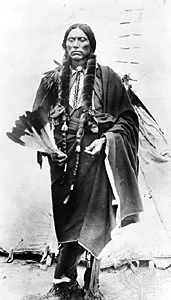 The great Comanche chief and war leader, Quanah Parker became a leader at a young age, and he was known for his bravery and his aggression as a warrior. I was drawn to this chief mostly because of his unusual name…both first and last. The first name was one I had never heard before, and the last seemed unusual for an Indian. Parker was born around 1848, near Wichita Falls, Texas, and died February 23, 1911, at Cache, near Fort Sill, Oklahoma. Quanah was the son of Chief Peta Nocona and Cynthia Ann Parker, a white woman captured by the Comanches as a child. Quanah is a Native American name that means “fragrant, or sweet smelling.” Quanah later added his mother’s surname to his given name. Their family was very happy until 1860, when the Texas Rangers attacked their encampment on the Pease River. While the stories of this event vary, there is no doubt that changed Quanah’s family forever, when the Rangers decided that Cynthia Ann and her young daughter, Prairie Flower should be returned to her people, even though that was against her wishes. It is believed that Quanah and Nocona were not there when the raid took place.
The great Comanche chief and war leader, Quanah Parker became a leader at a young age, and he was known for his bravery and his aggression as a warrior. I was drawn to this chief mostly because of his unusual name…both first and last. The first name was one I had never heard before, and the last seemed unusual for an Indian. Parker was born around 1848, near Wichita Falls, Texas, and died February 23, 1911, at Cache, near Fort Sill, Oklahoma. Quanah was the son of Chief Peta Nocona and Cynthia Ann Parker, a white woman captured by the Comanches as a child. Quanah is a Native American name that means “fragrant, or sweet smelling.” Quanah later added his mother’s surname to his given name. Their family was very happy until 1860, when the Texas Rangers attacked their encampment on the Pease River. While the stories of this event vary, there is no doubt that changed Quanah’s family forever, when the Rangers decided that Cynthia Ann and her young daughter, Prairie Flower should be returned to her people, even though that was against her wishes. It is believed that Quanah and Nocona were not there when the raid took place.
Quanah Parker was the last chief of the Kwahadi (Quahadi) band. He mounted an unsuccessful war against white expansion in northwestern Texas between 1874 and 1875. When that failed, he became the main spokesman and peacetime leader of the Native Americans in the region, a role which he performed for 30 years.
Quanah was a tall and muscular man, who became a full warrior at age 15. His reputation as an aggressive and fearless fighter was established after a series of successful raids. He became a war chief at a relatively young age as well, having gained the respect of his people. Quanah moved between several Comanche bands before joining the fierce Kwahadi, who were particularly bitter enemies of the hunter. The white Buffalo hunters had appropriated the best land on the Texas frontier and were decimating the buffalo herds. In order to stem the onslaught of Comanche attacks on settlers and travelers, the US government relegated the Indians to reservations in 1867. Quanah and his band refused to cooperate and continued their raids. Attempts by the US military to locate them were unsuccessful. In June 1874 Quanah and Isa-Tai, a medicine man who claimed to have a potion that would protect the Indians from bullets, gathered 250–700 warriors from among the Comanche, Cheyenne, and Kiowa and attacked about 30 white buffalo hunters quartered at Adobe Walls, Texas. The raid was a failure for the Kwahadi because a saloon owner had allegedly been warned of the attack, and the US military retaliated in force in what became known as the Red River Indian War. Quanah’s group held out on the Staked Plains for almost a year before he finally surrendered at Fort Sill.
Eventually Quanah agreed to settle on a reservation in southwestern Oklahoma, and he persuaded other Comanche bands to conform too. He soon became known as the principal chief of all Comanche. It was a position that had never existed before, and so was a great honor. As the chief of all Comanche, over the next three decades, he was the main interpreter of white civilization to his people, encouraging education and agriculture. He also tried to be an advocate on behalf of the Comanche, and soon became a successful businessman as well. Quanah also maintained elements of his own Indian culture, including polygamy, and he played a major role in creating a Peyote Religion that spread from 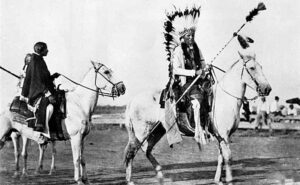 the Comanche to other tribes. He soon became a national figure, developing friendships with numerous notable men, including President Theodore Roosevelt, who invited Quanah to his inauguration in 1905. Roosevelt also visited Quanah at the chief’s home, a 10-room residence known as Star House, in Cache, Oklahoma.
the Comanche to other tribes. He soon became a national figure, developing friendships with numerous notable men, including President Theodore Roosevelt, who invited Quanah to his inauguration in 1905. Roosevelt also visited Quanah at the chief’s home, a 10-room residence known as Star House, in Cache, Oklahoma.
Quanah passed away in 1911, and was buried next to his mother, whose assimilation back into white civilization had been very difficult. Her white family blocked her repeated attempts to rejoin the Comanche, and in 1864 Prairie Flower died. Cynthia Ann was miserable and reportedly starved herself to death in 1870.
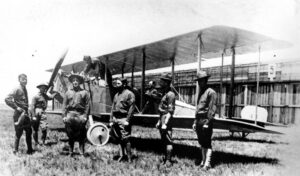 Imagine a time when there was no air force, or for that matter, airplanes. Of course, for those of us living today, that would be very hard to imagine…in fact, maybe impossible. Nevertheless, before the Wright brothers made flight possible, there was not only no planes, but no air force. Then, in 1914, things were about to change forever.
Imagine a time when there was no air force, or for that matter, airplanes. Of course, for those of us living today, that would be very hard to imagine…in fact, maybe impossible. Nevertheless, before the Wright brothers made flight possible, there was not only no planes, but no air force. Then, in 1914, things were about to change forever.
The First Aero Squadron was formed in 1914. It was organized after the start of World War I, but it was first used because of the Mexican revolutionary, Pancho Villa, who was initially a bandit, but later became a general in the Mexican Revolution. He was a key figure in the revolutionary violence that forced out President Porfirio Díaz and brought Francisco Madero to power in 1911. Pancho Villa was an excellent guerrilla leader who fought against the regimes of both of those men. After 1914, he engaged in civil war and banditry. He became notorious in the United States for his attack on Columbus, New Mexico, in 1916, and something had to be done
On March 9, 1916, Villa, who opposed American support for Mexican President Venustiano Carranza, led a band of several hundred guerrillas across the border on a raid of the town of Columbus, New Mexico. Seventeen Americans were killed in the battle. On March 15, President Woodrow Wilson ordered, US Brigadier General John J Pershing to launch a punitive expedition into Mexico to capture Villa. Four days later, the First Aero Squadron was sent into Mexico to scout and relay messages for General Pershing. On March 19, 1914, Eight Curtiss “Jenny” planes of the First Aero Squadron took off from Columbus, New Mexico, in the first combat air mission in United States history. The squadron was on a support mission for the 7,000 US troops who invaded Mexico to capture Villa.

Despite encountering numerous mechanical and navigational problems, the American pilots flew hundreds of missions for Pershing during which they gained important experience that would later be used by fliers over the battlefields of Europe. Unfortunately, during the 11-month mission, US forces failed to capture the elusive revolutionary, and Mexican resentment over US intrusion into their territory led to a diplomatic crisis. In late January 1917, with President Wilson under pressure from the Mexican government and more concerned with the war overseas than with bringing Villa to justice, the Americans were ordered home. The missions were over.
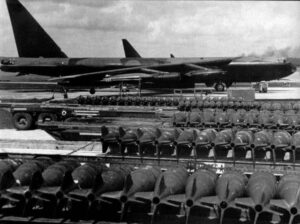 Why would the United States secretly bomb a neutral nation in the middle of a war with an enemy nation? That is the question I have been asking myself concerning the Menu Bombings…the bombing of neutral Cambodia during the Vietnam war. It was thought that bombing supply routes in Cambodia would weaken the enemies of the United States. I’m not sure that worked exactly. It did cut off the supply line, but innocent people were caught in the crossfire. Nevertheless, the decision was made to bomb Cambodia, and also to keep it a secret from the American public, who would most likely feel about it the same way, I do. Intentionally bombing innocent people just rubs most of us the wrong way.
Why would the United States secretly bomb a neutral nation in the middle of a war with an enemy nation? That is the question I have been asking myself concerning the Menu Bombings…the bombing of neutral Cambodia during the Vietnam war. It was thought that bombing supply routes in Cambodia would weaken the enemies of the United States. I’m not sure that worked exactly. It did cut off the supply line, but innocent people were caught in the crossfire. Nevertheless, the decision was made to bomb Cambodia, and also to keep it a secret from the American public, who would most likely feel about it the same way, I do. Intentionally bombing innocent people just rubs most of us the wrong way.
On March 15, 1969, President Richard Nixon approved the plan to bomb Cambodia. The actual missions began 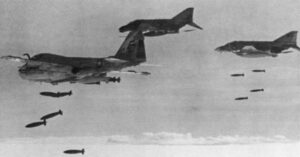 on March 18, 1969, when US B-52 bombers are diverted from their targets in South Vietnam to attack suspected communist base camps and supply areas in Cambodia for the first time in the war. This mission, originally intended to be called Operation Breakfast, and subsequent B-52 strikes inside Cambodia became known as the “Menu” bombings. The strikes included a total of 3,630 flights over Cambodia dropping 110,000 tons of bombs during a 14-month period through April 1970. This bombing of Cambodia and all follow up “Menu” operations were kept secret from the American public and the US Congress because Cambodia was considered a neutral nation. The missions had to be kept secret to avoid a public outcry…so, an intricate reporting system was established at the Pentagon to prevent disclosure of the bombing.
on March 18, 1969, when US B-52 bombers are diverted from their targets in South Vietnam to attack suspected communist base camps and supply areas in Cambodia for the first time in the war. This mission, originally intended to be called Operation Breakfast, and subsequent B-52 strikes inside Cambodia became known as the “Menu” bombings. The strikes included a total of 3,630 flights over Cambodia dropping 110,000 tons of bombs during a 14-month period through April 1970. This bombing of Cambodia and all follow up “Menu” operations were kept secret from the American public and the US Congress because Cambodia was considered a neutral nation. The missions had to be kept secret to avoid a public outcry…so, an intricate reporting system was established at the Pentagon to prevent disclosure of the bombing.

Somehow, the story was leaked by the New York Times in May of 1969, but there was little adverse public reaction. Now I find that incredible. The people were so “asleep” that they hardly noticed the bombing of a neutral country. It makes me wonder just how long the people have been asleep. How could people simply take no notice of such a huge violation of the rules of war. I’m sure there are things I don’t know about this war…lots of things, in fact, but I don’t think it is proper for our government to hide things for the people…especially such a big set of bombing missions on a neutral country. The people of this nation need to open our eyes and watch what our government is doing…before it’s too late.

 Once a year, we find ourselves puttin’ on a little bit o’ the Irish style, to step out and partake of the green Guinness beer, Corned Beef and Cabbage, and a number of other Irish treats, as we celebrate Saint Patrick’s Day. The day really isn’t about wearing green clothes, so you don’t get pinched, or drinking green beer, but rather a day to celebrate Saint Patrick, who came to Ireland in the fifth century and brought many of the people to Christ. In fact, in Ireland, the day is not a party day, but rather, a religious holiday, similar to Christmas and Easter. Things have changed some over the years, and these days you can find Saint Patrick’s Day parades, shamrocks, and green Guinness beer in Ireland, but it’s mostly there for the tourists who think that is the right way to celebrate the day. For most of the Irish people, however it would not be that way, and in fact, up until 1970 Irish laws mandated that pubs be closed on Saint Patrick’s Day. That is a stark contrast to the way the day is celebrated here, but the holiday doesn’t mean the same thing to Americans. I suppose that our Independence Day doesn’t mean the same thing to the Irish either.
Once a year, we find ourselves puttin’ on a little bit o’ the Irish style, to step out and partake of the green Guinness beer, Corned Beef and Cabbage, and a number of other Irish treats, as we celebrate Saint Patrick’s Day. The day really isn’t about wearing green clothes, so you don’t get pinched, or drinking green beer, but rather a day to celebrate Saint Patrick, who came to Ireland in the fifth century and brought many of the people to Christ. In fact, in Ireland, the day is not a party day, but rather, a religious holiday, similar to Christmas and Easter. Things have changed some over the years, and these days you can find Saint Patrick’s Day parades, shamrocks, and green Guinness beer in Ireland, but it’s mostly there for the tourists who think that is the right way to celebrate the day. For most of the Irish people, however it would not be that way, and in fact, up until 1970 Irish laws mandated that pubs be closed on Saint Patrick’s Day. That is a stark contrast to the way the day is celebrated here, but the holiday doesn’t mean the same thing to Americans. I suppose that our Independence Day doesn’t mean the same thing to the Irish either.
In the United States, Saint Patrick’s Day is a day to celebrate out Irish roots, and to participate in a little playful silliness. We celebrate with “pub crawls” and green coloring in rivers. While the Chicago River is the most prominent green river on Saint Patrick’s Day, there are currently others working to emulate the same effects or have done so in the past. The Irish Marching Society decided to bring the tradition to Rockford, Illinois and dye Rock River last year. San Antonio, Texas; Savannah, Georgia; Indianapolis, Indiana; Charlotte, North Carolina; Tampa, Florida; and Washington DC have all dyed various rivers green. In 2020, city officials in Dublin, Ireland decided to get in on the fun by dying the River Liffey green…as a way to get everyone involved.
I think most of us have some Irish background, but people may not know it. It seems to me that a lot of people have immigrated from Ireland over the years. In fact, many industries like mining and the rail roads, likely 
 would have been a ways behind where they were with the Irish immigrants. With the number of Irish immigrants that came over, there are probably very few families who don’t have a least a little bit of the Irish in them. Nevertheless, Irish or not, most of us like to celebrate the wearin’ of the green every year when Saint Paddy’s Day rolls around. So, whether you drink green beer or eat corned beef and cabbage, or simply wear green so you don’t get pinched, happy Saint Patrick’s Day to you all!!
would have been a ways behind where they were with the Irish immigrants. With the number of Irish immigrants that came over, there are probably very few families who don’t have a least a little bit of the Irish in them. Nevertheless, Irish or not, most of us like to celebrate the wearin’ of the green every year when Saint Paddy’s Day rolls around. So, whether you drink green beer or eat corned beef and cabbage, or simply wear green so you don’t get pinched, happy Saint Patrick’s Day to you all!!
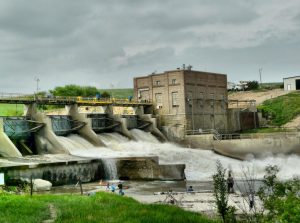
 The town of Spencer, Nebraska is a small town of just 423 people, but on March 14, 2019, the town became more well known that it probably ever dreamed it could, or even wanted to be. Suddenly, Spencer, Nebraska was big news, or at least the dam there was. Events unfolded that lead to the collapse of the 93-year-old dam, when the pressure from an icy flood mixed with an area that had a history of unaddressed ice problems. Perhaps it was the rural area of the state, or that they misjudged the surge that could follow a collapse, but they didn’t think that many people would be affected and certainly that no one would die, should the Spencer dam fail. That proved to be untrue, when Kenny Angel, who lived just beneath the dam, was found dead after the flood washed away his home and business. Workers for the Nebraska Public Power District, which operated the dam, warned Angel just minutes ahead of time of the impending danger.
The town of Spencer, Nebraska is a small town of just 423 people, but on March 14, 2019, the town became more well known that it probably ever dreamed it could, or even wanted to be. Suddenly, Spencer, Nebraska was big news, or at least the dam there was. Events unfolded that lead to the collapse of the 93-year-old dam, when the pressure from an icy flood mixed with an area that had a history of unaddressed ice problems. Perhaps it was the rural area of the state, or that they misjudged the surge that could follow a collapse, but they didn’t think that many people would be affected and certainly that no one would die, should the Spencer dam fail. That proved to be untrue, when Kenny Angel, who lived just beneath the dam, was found dead after the flood washed away his home and business. Workers for the Nebraska Public Power District, which operated the dam, warned Angel just minutes ahead of time of the impending danger.
The dam was operated by the Nebraska Public Power District (NPPD). Heavy precipitation during the March 2019 North American blizzard led to a failure of the dam in the early morning hours of March 14th, causing heavy flooding downstream. For a dam that was not expected to do much damage, if it failed, the damage was really devastating…affecting four counties. An 11-foot wall of water was released by the failure, as recorded by a US Geological Survey stream gage moments before it was washed away.
Nebraska regulators had categorized Spencer Dam as a “significant hazard,” which is a rating that meant no loss of life was expected if it failed. With that, no formal emergency action plan was required. After the collapse, it was noted that the Association of State Dam Safety Officials said the dam should have been rated as “high hazard,” which could have led to a plan to modify it to increase its flood capacity. Unfortunately, that was not done, and the failure was terrible. Knox County, the hardest hit of the four counties affected, saw estimates of more than $17M in damages. While the Spencer dam had a history of ice related issues, and other dams may have had ice issues too, the Spencer dam might just be the first dam in the nation to collapse due to 
 those ice issues. The 11-foot surge of water that followed the collapse took out roads, highways, homes, businesses, and bridges. For several months, motorists were required to detour 150 miles to get past the damage. The flood cut a new channel in the river, meaning a new 1050-foot section of the bridge on Highway 281 below the dam.
those ice issues. The 11-foot surge of water that followed the collapse took out roads, highways, homes, businesses, and bridges. For several months, motorists were required to detour 150 miles to get past the damage. The flood cut a new channel in the river, meaning a new 1050-foot section of the bridge on Highway 281 below the dam.
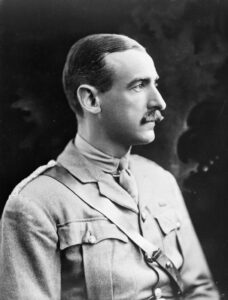 The unkillable soldier…a nickname that has deep ramifications, and a nickname no one really wants to have. It indicates that the soldier is wounded multiple times…and somehow survived. General Adrian Carton de Wiart was that soldier. He was born into an aristocratic family in Brussels, on May 5, 1880. He was the eldest son of Léon Constant Ghislain Carton de Wiart and Ernestine Wenzig. He spent his early days in Belgium and in England. When he was six years old, his parents divorced, and he moved with his father to Cairo. His mother remarried Demosthenes Gregory Cuppa later in 1886. His father was a lawyer and magistrate, as well as a director of the Cairo Electric Railways and Heliopolis Oases Company and was well connected in Egyptian governmental circles. Adrian Carton de Wiart learned to speak Arabic. He joined the British Army at the time of the Second Boer War around 1899, where he entered under the false name of “Trooper Carton,” claiming to be 25 years old, but he was actually 20. He was wounded in the stomach and groin in South Africa early in the Second Boer War and was sent home to recuperate. His father was furious when he learned his son had abandoned his studies. Nevertheless, he allowed his son to remain in the army.
The unkillable soldier…a nickname that has deep ramifications, and a nickname no one really wants to have. It indicates that the soldier is wounded multiple times…and somehow survived. General Adrian Carton de Wiart was that soldier. He was born into an aristocratic family in Brussels, on May 5, 1880. He was the eldest son of Léon Constant Ghislain Carton de Wiart and Ernestine Wenzig. He spent his early days in Belgium and in England. When he was six years old, his parents divorced, and he moved with his father to Cairo. His mother remarried Demosthenes Gregory Cuppa later in 1886. His father was a lawyer and magistrate, as well as a director of the Cairo Electric Railways and Heliopolis Oases Company and was well connected in Egyptian governmental circles. Adrian Carton de Wiart learned to speak Arabic. He joined the British Army at the time of the Second Boer War around 1899, where he entered under the false name of “Trooper Carton,” claiming to be 25 years old, but he was actually 20. He was wounded in the stomach and groin in South Africa early in the Second Boer War and was sent home to recuperate. His father was furious when he learned his son had abandoned his studies. Nevertheless, he allowed his son to remain in the army.
In 1908, he married Countess Friederike Maria Karoline Henriette Rosa Sabina Franziska Fugger von Babenhausen (1887 – 1949), eldest daughter of Karl, 5th Fürst (Prince) von Fugger-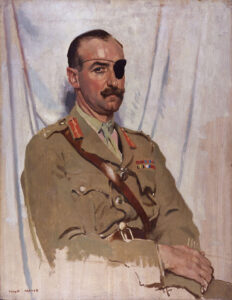 Babenhausen and Princess Eleonora zu Hohenlohe-Bartenstein und Jagstberg of Klagenfurt, Austria. They had two daughters, the elder of whom Anita (born 1909, now deceased) was the maternal grandmother of the war correspondent Anthony Loyd (born 1966). I wonder if Loyd was inspired by his grandfather’s story.
Babenhausen and Princess Eleonora zu Hohenlohe-Bartenstein und Jagstberg of Klagenfurt, Austria. They had two daughters, the elder of whom Anita (born 1909, now deceased) was the maternal grandmother of the war correspondent Anthony Loyd (born 1966). I wonder if Loyd was inspired by his grandfather’s story.
Over the course of his career, General Adrian Carton de Wiart earned the nickname “the unkillable soldier.” By 1915, he was promoted to captain and had already survived his first war…the Boer War. One night, near the French battlefield of Ypres, he and a small group of officers wandered too far into enemy territory and ran into a group of German soldiers, who fired. De Wiart was badly shot in the hand but scrambled back to his regiment. According to his memoirs, he used a “scarf he’d taken off a slain German soldier to stop the bleeding.” He was taken to a hospital where surgeons debated what to do about the gory mess of dangling fingers that had been his hand. De Wiart said, “I asked the doctor to take my fingers off; he refused, so I pulled them off myself and felt absolutely no pain in doing it.” De Wairt’s injuries were not over yet. The hand became infected and later had to be amputated. Three weeks later, De Wiart and returned to duty. He was shot several more times in his career, survived two plane crashes, and lost an eye. Over the course of four conflicts, 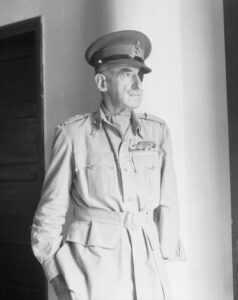 he sustained 11 grievous injuries, and simply could not be killed in war.
he sustained 11 grievous injuries, and simply could not be killed in war.
En route home via French Indochina, Carton de Wiart stopped in Rangoon as a guest of the army commander. Coming down the stairs, he slipped on coconut matting, fell down, broke several vertebrae, and knocked himself unconscious. He was admitted to Rangoon Hospital where he was treated and recovered. His wife died in 1949. Then, in 1951, at the age of 71, he married Ruth Myrtle Muriel Joan McKechnie, a divorcee known as Joan Sutherland, 23 years his junior (born in late 1903, she died January 13, 2006, at the age of 102.) They settled at Aghinagh House, Killinardrish, County Cork, Ireland. Carton de Wiart died at the age of 83 on June 5, 1963. He left no papers. He and his wife Joan are buried in Caum Churchyard just off the main Macroom road. The grave site is just outside the actual graveyard wall on the grounds of his own home.
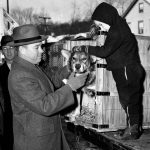
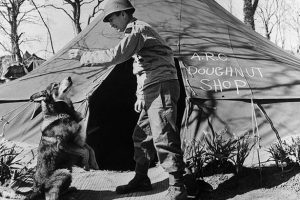 As most of us know, dogs have been used in many kinds of work from K-9 units to military units to guide dogs, to cadaver dogs, and many more. During World War II, one such dog named Chips, who was a Shepherd-Collie-Husky mix, served for 3.5 years of the war. When the US entered World War II, the military actually asked Americans to “donate” their dogs to serve on patrols and guard duty. That seems so strange to me. How could the dog know what was going on? How could it not get depressed or aggressive, thinking its owner was dead or had abandoned it? It’s one thing to send a soldier into a war situation, they have either been legally drafted or they freely joined up, but a dog…or any animal for that matter, couldn’t possibly understand why, after having a family of their own, they were suddenly in a foreign country, without their owner, their own bed, or their home.
As most of us know, dogs have been used in many kinds of work from K-9 units to military units to guide dogs, to cadaver dogs, and many more. During World War II, one such dog named Chips, who was a Shepherd-Collie-Husky mix, served for 3.5 years of the war. When the US entered World War II, the military actually asked Americans to “donate” their dogs to serve on patrols and guard duty. That seems so strange to me. How could the dog know what was going on? How could it not get depressed or aggressive, thinking its owner was dead or had abandoned it? It’s one thing to send a soldier into a war situation, they have either been legally drafted or they freely joined up, but a dog…or any animal for that matter, couldn’t possibly understand why, after having a family of their own, they were suddenly in a foreign country, without their owner, their own bed, or their home.
Nevertheless, when their country asked, over 11,000 Americans volunteered their pets, including Chips’s owner, John Wren of Pleasantville, New York. Chips the first “volunteer” dog in the United States, took part in the invasion of Sicily, just a year into his deployment. When an Italian machine gunner pinned down Chips and his squad, he broke away from his leash and charged into the enemy position. A single shot rang out. Then, the Italian gunner emerged with Chips at his throat, followed by three more soldiers. They all quickly surrendered. Chips received a wound on his scalp and burns on his mouth and left eye. That didn’t stop this hero dog, who kept fighting and helped capture 10 more soldiers that day.
After the war, per their request, it was time for Chips to be returned to his family. Plans would have to be put in place for that to happen. So, in the fall of 1945 he was taken back to Front Royal where he was retrained so that he could go back to his family. A dog who had been in combat couldn’t just go back to his family as if nothing had happened. Finally in December of 1945, he traveled home to Pleasantville, riding in the baggage car of a train. He didn’t go alone. He was accompanied by six reporters and photographers who wanted to 
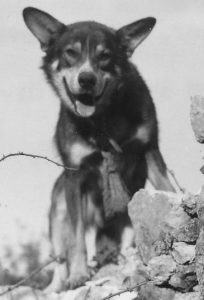 cover the story. They were met by Mr and Mrs Wren and their son, Johnny, who was only a baby when Chips left. The girls raced home after school to see their dog. It was a sweet homecoming. Chips lived for just four months before his kidneys failed. I guess war had taken its toll.
cover the story. They were met by Mr and Mrs Wren and their son, Johnny, who was only a baby when Chips left. The girls raced home after school to see their dog. It was a sweet homecoming. Chips lived for just four months before his kidneys failed. I guess war had taken its toll.
Chips’s story made him an international sensation. He received a Silver Star for his heroics. Unfortunately, some people thought that a dog shouldn’t be awarded the same medal as a human, so it was revoked. Then, in 2018, he was awarded the PDSA Dickin Award, the highest honor for wartime bravery for an animal. A well-deserved honor. While his award was amazing, I think that the family should have also received an award, as should all of the other families who donated their dogs for the war effort. It was a very selfless act.

 The day after the debut of the Barbi doll on March 9, 1959, at the American Toy Fair in New York City, the doll had become an instant sensation. Basically, her debut makes Barbie 63 years old. The old girl has aged very well. In fact, she hasn’t aged a bit, although she can’t say she hasn’t had any work done. The reality is that Barbie has been redesigned at least every year. Of course, that isn’t saying she has had plastic surgery…or is it? She is, after all, made of plastic.
The day after the debut of the Barbi doll on March 9, 1959, at the American Toy Fair in New York City, the doll had become an instant sensation. Basically, her debut makes Barbie 63 years old. The old girl has aged very well. In fact, she hasn’t aged a bit, although she can’t say she hasn’t had any work done. The reality is that Barbie has been redesigned at least every year. Of course, that isn’t saying she has had plastic surgery…or is it? She is, after all, made of plastic.
Barbie stands eleven inches tall, and at first anyway, had long blond hair. These days, of course as hairstyles have changed and it was decided that not all girls are blonds, her hair color and style have changed with the times. She has been given lots of cool clothes, shoes, a house, car, RV, and boat…and probably many other things. Barbie was the first mass-produced toy doll in the United States with adult features. I suppose that she caused quite a stir with many parents, but for girls everywhere, she was the princess they were going to be when they grew up. I know I couldn’t wait to get one.
The woman behind Barbie was Ruth Handler, who co-founded Mattel, Inc with her husband in 1945. Handler witnessed her young daughter ignore her baby dolls to play make-believe with paper dolls of adult women, at which point she realized there was an important niche in the market for a toy that allowed little girls to imagine the future. Barbie’s appearance was modeled on a doll named Lilli, based on a German comic strip character. Lilli was originally marketed as a racy gag gift to adult men in tobacco shops, but she later became extremely popular with children. Mattel bought the rights to Lilli and made its own version, which Handler named after her daughter, Barbara.
In 1955, Mattel became a sponsor of the “Mickey Mouse Club” TV program. With that, Mattel became one of the first toy companies to broadcast commercials aimed specifically at children. They used their commercials to promote their new toy, and by 1961, the enormous consumer demand for the doll led Mattel to release a boyfriend for Barbie. Handler named him Ken, after her son. Then, Barbie’s best friend, Midge, came out in 1963; her little sister, Skipper, debuted in 1964.
Of course, the Barbie doll was not without controversy. On a positive note, many women saw Barbie as providing an alternative to traditional 1950s gender roles. Her many careers, like airline stewardess, doctor, pilot, astronaut, Olympic athlete, and even US presidential candidate made some women see a possible future that was different 
 than was common in the 1950s. Others thought Barbie’s never-ending supply of designer outfits, cars, and “Dream Houses” encouraged kids to be materialistic. However, the biggest controversy was over Barbie’s appearance. Her figure was unrealistic for a real woman. It was estimated that if she were a real woman, her measurements would be 36-18-38–led many to claim that Barbie provided little girls with an unrealistic and harmful example and fostered negative body image. Nevertheless, even with the criticism, Barbie never lost her appeal, and in fact she is as popular today as she ever was. I was just 3 years old when Barbie came out, and today, my great granddaughter, Cambree Petersen loves her Barbie dolls as much as I did, even if Barbie is…old!!!
than was common in the 1950s. Others thought Barbie’s never-ending supply of designer outfits, cars, and “Dream Houses” encouraged kids to be materialistic. However, the biggest controversy was over Barbie’s appearance. Her figure was unrealistic for a real woman. It was estimated that if she were a real woman, her measurements would be 36-18-38–led many to claim that Barbie provided little girls with an unrealistic and harmful example and fostered negative body image. Nevertheless, even with the criticism, Barbie never lost her appeal, and in fact she is as popular today as she ever was. I was just 3 years old when Barbie came out, and today, my great granddaughter, Cambree Petersen loves her Barbie dolls as much as I did, even if Barbie is…old!!!
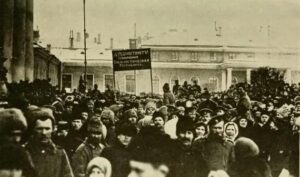 How can the February Revolution begin on March 8th, you might ask? Well, if you know much about 1917 Russia, you know that the calendar at that time was the Julian calendar, and not the Gregorian calendar that we use today in most countries. That was how the February Revolution (known as such because of Russia’s use of the Julian calendar) which began on February 23rd in the Julian calendar, actually began on March 8th in the now-used Gregorian calendar. The February Revolution started with riots and strikes over the scarcity of food erupt in Petrograd. One week later, centuries of czarist rule in Russia ended with the abdication of Czar Nicholas II, and Russia took a dramatic step closer to a communist revolution.
How can the February Revolution begin on March 8th, you might ask? Well, if you know much about 1917 Russia, you know that the calendar at that time was the Julian calendar, and not the Gregorian calendar that we use today in most countries. That was how the February Revolution (known as such because of Russia’s use of the Julian calendar) which began on February 23rd in the Julian calendar, actually began on March 8th in the now-used Gregorian calendar. The February Revolution started with riots and strikes over the scarcity of food erupt in Petrograd. One week later, centuries of czarist rule in Russia ended with the abdication of Czar Nicholas II, and Russia took a dramatic step closer to a communist revolution.
By 1917, Czar Nicholas II had already lost all of his credibility. The corruption in the government was rampant, the economy was a mess, and Nicholas repeatedly dissolved the Duma…the Russian parliament established after the Revolution of 1905…whenever it opposed his will. All that was bad, but the immediate cause of the February Revolution, which was the first phase of the Russian Revolution of 1917…was Russia’s disastrous involvement in World War I. Militarily, Russia was no match for industrialized Germany, and Russian casualties were greater than those sustained by any nation in any previous war. They were severely pounded by the Germans. Meanwhile, the economy was hopelessly disrupted by the costly war effort, and moderates joined Russian radical elements in calling for the overthrow of the czar, who was already weak due to family problems, namely a sick child.
While most of the world switched from the Julian calendar to the Gregorian calendar in 1582, Russia didn’t make the conversion until 1918. So, 104 years ago, the Russian people irrevocably had half a month wiped out of their lives…13 days of February in 1918. Their calendar went from January 31, 1918, to February 14, 1918…overnight. On March 8th or February 23rd, 1917, depending on the calendar you choose to use for the event, demonstrators were clamoring for bread in the streets of the Russian capital of Petrograd (now known as Saint Petersburg). Supported by 90,000 men and women on strike, the protesters clashed with police but refused to leave the streets. The strike spread, and on March 10th, it had spread among all of Petrograd’s workers, and irate mobs of workers destroyed police stations. Several factories elected deputies to the Petrograd Soviet, or “council” of workers’ committees, following the model devised during the Revolution of 1905.
By March 11th, the troops of the Petrograd army garrison ordered soldiers to crush the uprising. Regiments opened fire, killing demonstrators, but the protesters kept to the streets, and the troops began to waver. Nicholas dissolved the Duma again on that day, and on March 12, the revolution triumphed when regiment after regiment of the Petrograd garrison defected to the cause of the demonstrators. The soldiers, some 150,000 men, subsequently formed committees that elected deputies to the Petrograd Soviet.
The uprising forced the imperial government to resign, and the Duma formed a provisional government that peacefully vied with the Petrograd Soviet for control of the revolution. March 14th, saw the Petrograd Soviet 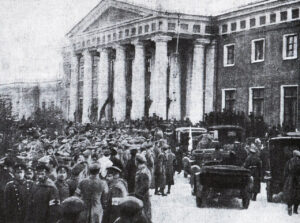 issuing “Order No. 1,” which instructed Russian soldiers and sailors to obey only those orders that did not conflict with the directives of the Soviet. Czar Nicholas II abdicated the throne the next day, March 15th, in favor of his brother Michael, who refused the crown, ending the czarist autocracy.
issuing “Order No. 1,” which instructed Russian soldiers and sailors to obey only those orders that did not conflict with the directives of the Soviet. Czar Nicholas II abdicated the throne the next day, March 15th, in favor of his brother Michael, who refused the crown, ending the czarist autocracy.
The Petrograd Soviet tolerated the new provincial government and hoped to salvage the Russian war effort while ending the food shortage and many other domestic crises…a daunting task. Meanwhile, Vladimir Lenin, leader of the Bolshevik revolutionary party, left his exile in Switzerland and crossed German enemy lines to return home and take control of the Russian Revolution.
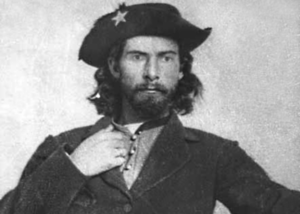 William T Anderson’s life was always rather a violent one, but it escalated when his sister died while in the custody of the Union soldiers during the Civil War. Anderson was born around 1840 in Hopkins County, Kentucky, to William and Martha Anderson. His siblings were Jim, Ellis, Mary, Josephine, and Martha. His schoolmates recalled him as a well-behaved, reserved child, so they might be surprised to see how he ended up. Anderson began to support himself early on, by stealing and selling horses in 1862. After a Union loyalist judge killed his father, Anderson killed the judge and fled to Missouri. He was always one to exact revenge for anything in which he felt that he or his family were wronged. In Missouri, he robbed travelers and killed several Union soldiers.
William T Anderson’s life was always rather a violent one, but it escalated when his sister died while in the custody of the Union soldiers during the Civil War. Anderson was born around 1840 in Hopkins County, Kentucky, to William and Martha Anderson. His siblings were Jim, Ellis, Mary, Josephine, and Martha. His schoolmates recalled him as a well-behaved, reserved child, so they might be surprised to see how he ended up. Anderson began to support himself early on, by stealing and selling horses in 1862. After a Union loyalist judge killed his father, Anderson killed the judge and fled to Missouri. He was always one to exact revenge for anything in which he felt that he or his family were wronged. In Missouri, he robbed travelers and killed several Union soldiers.
Anderson became a guerrilla, when his family was living in Council Grove, Territory of Kansas at the start of the Civil War. After William Quantrill’s raid on Aubry, Kansas on March 7, 1862, a Federal company from Olathe, Kansas sent a patrol from Company D, Eighth Kansas Jayhawker Regiment to investigate. Their mission was to seek out Southern sympathizers living nearby, who might be accused of aiding the raiders. Anderson’s father and uncle were named as such, and when the Jayhawker company arrived at the Anderson farm on March 11th, William and his younger brother Jim were delivering 15 head of cattle to the US commissary agent at Fort Leavenworth. When the brothers returned to their farm, they found their father and uncle hanged in retaliation, their home burned to the ground, and all their possessions stolen. It was an act of war in their minds, because the men had no chance to defend themselves. Two days later Bill and his brother Jim were both riding with Quantrill’s Raiders, a group of Confederate guerrillas operating along the Kansas–Missouri border. Anderson moved his sisters from Kansas, and for a year they lived at various places stopping finally with the Mundy family on the Missouri side of the line near Little Santa Fe. When asked why he joined Quantrill, Anderson replied by saying, “I have chosen guerrilla warfare to revenge myself for wrongs that I could not honorable revenge otherwise. I lived in Kansas when this war commenced. Because I would not fight the people of Missouri, my native State, the Yankees sought my life but failed to get me. [They] revenged themselves by murdering my father, [and] destroying all my property.”
Anderson became a skilled bushwhacker and quickly earned the trust of the group’s leaders, William Quantrill and George M Todd. It was his bushwhacking skills that ultimately marked him as a dangerous man…and eventually led the Union to imprison his sisters. Then, after a building collapse in the makeshift jail in Kansas City, Missouri, left one of his sisters dead, while in custody and the others permanently maimed, Anderson devoted himself to revenge. He took a leading role in the Lawrence Massacre and later took part in the Battle of Baxter Springs, both in 1863. He later satisfied his revenge by hijacking a train full of Union troops and slaughtering 24 of them, thus giving him the name “Bloody Bill” Anderson.
By 1863, all Bill had left was a brother and two sisters, who had miraculously survived the August 13 Union jail collapse in Kansas City. The collapse wasn’t an accident. Union guards from the 9th Kansas Jayhawker Regiment, serving as provost guards in town, intentionally collapsed a three-story brick building on a number of young Southern female prisoners. Fourteen-year-old Josephine Anderson was killed in the collapse. Bill’s ten-year-old sister Martha’s legs were horribly crushed crippling her for life, and his sixteen-year-old sister Mary suffered serious back injuries and facial lacerations. Both girls would carry their physical and emotional scars for the rest of their lives. War is an ugly thing, and unfortunately, sometimes unscrupulous people do things  they shouldn’t. The atrocity at the jail was a war crime and should have been punished as such, but I suppose that didn’t justify the murders that followed, because there was no proof that those murdered were involved in any way.
they shouldn’t. The atrocity at the jail was a war crime and should have been punished as such, but I suppose that didn’t justify the murders that followed, because there was no proof that those murdered were involved in any way.
Union military leaders ordered Lieutenant Colonel Samuel P Cox to kill Anderson and provided him with a group of experienced soldiers. A local woman saw Anderson soon after he left Glasgow and told Cox where he was. On October 26, 1864, Cox pursued Anderson’s group with 150 men and engaged them in a battle called the Skirmish at Albany, Missouri. Anderson and his men charged the Union forces, killing five or six of them, but turned back under heavy fire. Only Anderson and one other man, the son of a Confederate general, continued to charge after the others had retreated. Anderson was hit by a bullet behind an ear, which most likely killed him instantly. Four other guerrillas were killed in the attack as well. The victory made a hero of Cox and led to his promotion.

